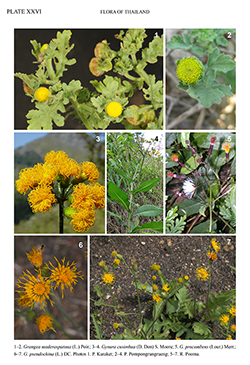e-Flora of Thailand
Volume 13 > Part 2 > Year 2016 > Page 322 > Compositae (Asteraceae) > Gynura
10. Gynura pseudochina (L.) DC.wfo-0000084902
Prodr. 6: 299. 1838; Kerr, Fl. Siam. 2(3): 289. 1936; Backer & Bakh.f., Fl. Java 1: 424. 1965; H.Koyama, Acta Phytotax. Geobot. 39: 154. 1988, excl. syn. G. truncata; F.G.Davies, Kew Bull. 33: 638. 1979; Gould in Hara, Chater & Williams, ed., Enum. Fl. Pl. Nepal 3: 30. 1982; Chen, Fl. Reipubl. Popularis Sin. 77(1): 310. 1999; Y.L.Chen & B.Nord., Fl. China 20–21: 539. 2011.— Senecio pseudochina L., Sp. Pl. 2: 867. 1753.— Crassocephalum pseudochina (L.) Kuntze, Revis. Gen. Pl. 1: 331. 1891. Plate XXVI: 6.
Accepted Name : This is currently accepted.
Description : Fleshy perennial herb, 20–80 cm tall, from tubers; stems, erect, with rosette leaves; root producing rounded, sometimes lobed tubers, 2–6 cm diam. Leaves all cauline; lower leaves somewhat smaller than median leaves; blade obovate, spathulate, elliptic or ovate in outline, 7–14 by 1.5–6 cm, simple to deeply lobed, apex obtuse, base narrowed down petioles; petioles 0.3–3 cm long; median and upper leaves more dissected than lower leaves; uppermost leaves pinnatisect. Inflorescences simple or 1–2 branched with 1–5 capitula, bearing small, leaf-like, auriculate bracts at each branch; peduncles 0.5–6 cm long, pubescent. Capitula: involucres campanulate, 8–12 by ca 10 mm; calyculate, calycular bracts ca 6, 2–4 mm long, ciliate; phyllaries 13–15, uniseriate, lanceolate, ca 2.5 mm wide, margins narrowly hyaline; receptacle slightly convex, naked. Florets ca 40 per capitulum; corollas yellow to red, 13–16 mm long, apex 5-lobed, lobes ca 1 mm long, basal tube ca 6 mm long. Achenes (immature) 10-ribbed, ribs pale brown, grooves dark brown, glabrous; pappus of capillary bristles, ca 14 mm long, white.
Thailand : NORTHERN: Chiang Mai (Doi Chang, Doi Suthep, Doi Chiang Dao, Bo Luang to Om Koi), Chiang Rai (Mae Sruai), Phitsanulok (Thung Salaeng Luang NP); NORTH-EASTERN Phetchabun (Nam Nao, Ban Phu Hi), Loei (Phu Kradueng); EASTERN: Nakhon Ratchasima (Bua Yai, Pak Thong Chai), Buriram, Srisaket (Kanthararom); SOUTH- WESTERN: Uthai Thani (Huai Kha Khaeng WS); CENTRAL: Saraburi (Sam Lan), Nakhon Nayok (Khao Yai).
Distribution : N India (type), S China, Myanmar, Indonesia (Java).
Ecology : Open mountain slopes or open pine forests, 600–1,300 m alt. Flowering: March–July.
Vernacular : Kham khok (คำาโคก)(Khon Kaen, Loei); phakkat kop (ผักกาดกบ)(Phetchabun); phakkat dong (ผักกาดดง)(Loei); phakkat din (ผักกาดดิน)(Mae Hong Son); phakkat nok khao (ผักกาดนกเขา)(Surat Thani, Nakhon Si Thammarat); nat haeng (หนาดแห้ง)(Nakhon Ratchasima).

